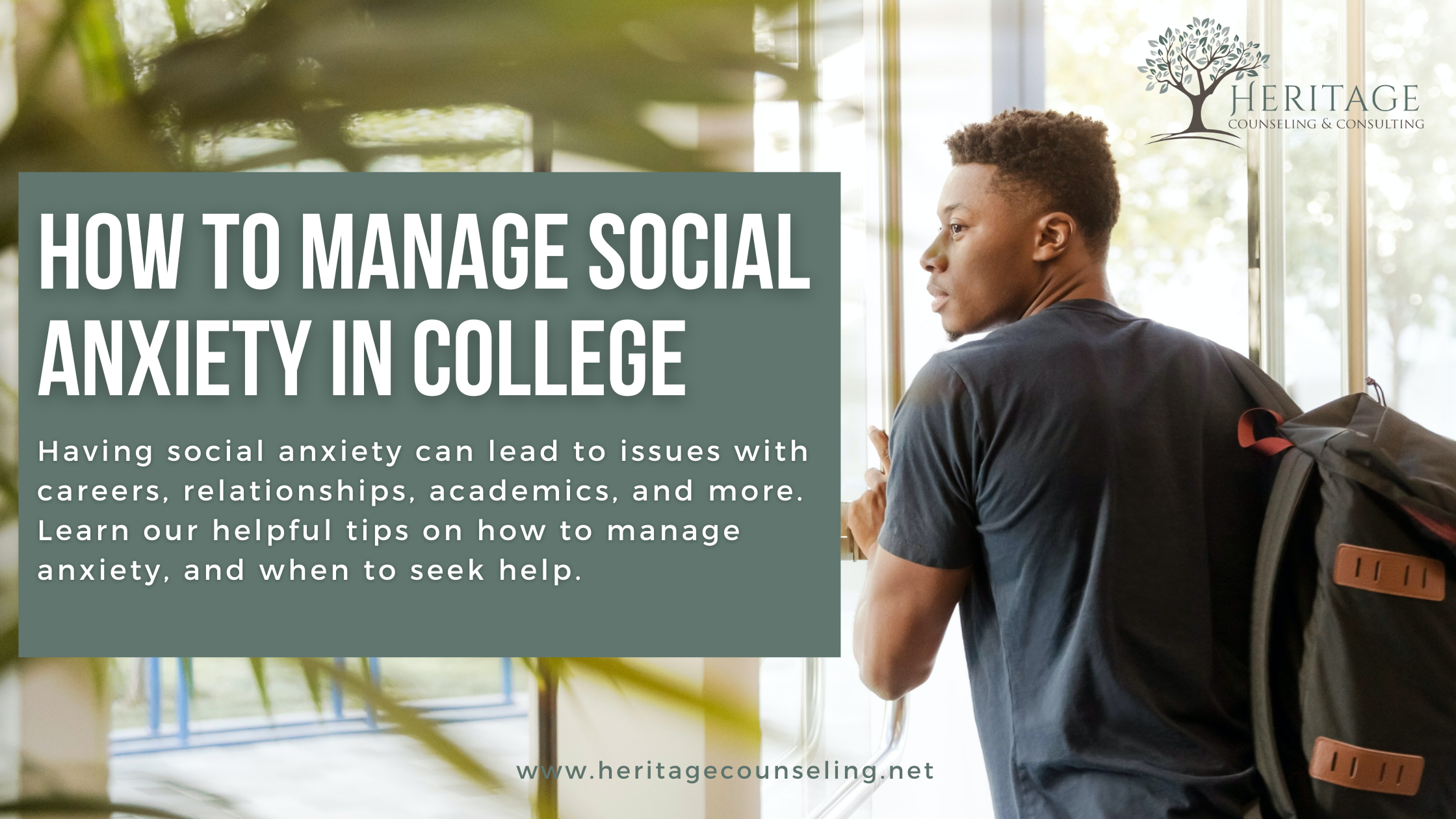What is Social Anxiety?
Social anxiety disorder (SAD), also known as social phobia, is a condition marked by persistent, overwhelming fear of social situations. Although it is normal to sometimes feel nervous or unsure of yourself during social interactions, someone with SAD has anxiety that impairs daily functioning. The fear of negative judgment and the desire to leave positive perceptions can be one of the major sources of debilitating anxiety. Everyday interactions with peers can become exhausting and result in self-deprecating thoughts involving embarrassment, shame, guilt, and self-consciousness. Those negative thoughts can often spiral into greater issues such as depression, substance use disorder, and even suicidality.
An estimated 7% of American adults are believed to have SAD and it can be caused by a multitude of factors such as childhood trauma, personalities that are naturally more reserved, and genetic vulnerability. However, the period of adolescence into emerging adulthood is the prime time that many may be diagnosed with SAD for many reasons. There is increased prominence of complex social interaction during adolescence and young adulthood that isn’t seen in earlier childhood. As teenagers form their own distinct identities, they have the desire to influence others while also being easily influenced, which puts a large amount of pressure on them to be socially accepted. In college, young adults have the opportunity to form professional, formal relationships with their peers and mentors to help them as they jump-start their careers. Although these relationships are beneficial, there is still the added pressure of forming your own identity throughout college, and shaping your identity around these people puts the added desire to leave positive impressions on them. The unique environment in college has led to 47.2% of students having at least mild social anxiety symptoms while 10.5% of students experience severe social anxiety symptoms. The percentage of students diagnosed with SAD is estimated to be around 18%.
What are the Possible Symptoms of Social Anxiety?
Emotional and Behavioral:
Fearing negative judgment from others
Constant worry about humiliation or embarrassment
Fear of others noticing your anxiety or physical symptoms of anxiety
Avoidance of social events or situations where you are the center of attention
Anxiety in anticipated events
Expecting the worst from negative social interactions
Overthinking and critiquing your own previous social interactions
Physical:
Sweating
Muscle tension
Lightheadedness
Nausea
Blushing
Trembling
Increased heart rate
How Does Social Anxiety Impact College Students?
Academic Performance
Those with social anxiety can experience great difficulty in succeeding in college because of how necessary group projects and public speaking are in some classes. Additionally, sometimes, students are graded purely on participation and actively engaging in classes. Even if students are knowledgeable about what they are learning, not being able to verbalize it can lead to negative consequences. It can feel incredibly liberating to move out of your comfort zone by attending college and managing your own responsibilities, but not everyone feels this way. Some can find the newfound independence terrifying and so intimidating that being completely responsible for your own schedule, GPA, scholarships, financial aid, graduation, and more can lead to overwhelming nervousness. It is no surprise that those with SAD are more likely to have lower GPAs and higher dropout rates than students without social anxiety.
Relationships (peers, professors, networking)
College is the ideal place for young adults to get themselves out there to make long-term friends and even to meet potential colleagues. However, those with social anxiety will struggle to make the most of their college experience by minimizing how much they try to push themselves into new social circles. This can apply in both a professional and casual setting. It’s important for young adults to build their social network in college, especially building them around those with the same career goals. Anyone within the same specialty like a peer or professor can be a good resource to any students who are hoping to begin their long-term career. Additionally, Boukhechba et al. (2018) found that students who struggle with social anxiety disorder are more likely to spend the majority of their time outside of classes (on evenings and weekends) at home. This means that students with social anxiety are not taking advantage of their campus community through clubs, Greek life, volunteer organizations, student government, and other student-oriented groups. Being overly nervous or anxious about joining these groups acts as self-sabotage because participating in social circles such as those can act as a support system against the stressors of emerging adulthood. Without an outlet for stress and self-isolation, students can become more vulnerable to other mental health issues.
Comorbidity
Unfortunately, treatment for social anxiety is usually rare and delayed, and it often only comes when a person is seeking help for another psychological disorder. When those with SAD do opt for treatment, they are more likely to consider their social anxiety a symptom of another disorder or a secondary problem rather than an issue to directly treat. SAD has a high likelihood of overlapping with Major Depressive Disorder and Substance Use Disorder. Each additional diagnosis on top of one’s anxiousness leads to increasingly complex treatment and a greater degree of impaired functioning. For young adults in school, this could mean not attending class, missing due dates, procrastination, and eventually, complete withdrawal from school. Because SAD is a strong predictor of other mental health disorders, students are often dealing with more than one issue on top of academic pressures and personal matters. It is best for students to get help for their social anxiety as soon as possible so they can get the most out of their college experience and prevent further issues.
Career Goals
College is a key stepping stone for any young adult that is trying to start their career and with that comes social situations that can make someone with SAD extremely nervous. The initial interview and screening process that everyone has to go through for jobs can be extremely nerve-wracking, even for those without social anxiety. It is not uncommon for those with social anxiety to turn down job offers or promotions because they are anxious, even though they would be beneficial. Additionally, most jobs value strong communication skills, verbal reasoning, and the ability to work in a team. Without the social skills necessary to approach these jobs, those with SAD can reduce their job prospects and delay their career goals.
Tips on Managing Social Anxiety
1. Reassess Cognitive Distortions
Cognitive distortions are skewed thoughts, beliefs, or perceptions that can lead to rumination. They can lead to biased, negative feelings that make us discouraged from engaging in a behavior and only work to make us anxious about the future. Social anxiety can result in a number of cognitive distortions such as overgeneralization (using previous experiences as reference for future events), catastrophizing (thinking of the worst possible scenario), and personalization (blaming yourself for an outcome). Being able to look at these skewed perceptions from a broader perspective can help someone with SAD reassess social situations in a more positive light. Challenging these distortions can make someone more open to challenging themselves socially without overthinking the details of each interaction, leading to less anxiousness.
2. Recognize Small Social Achievements
Those with social anxiety tend to undersell themselves and are overly critical of their own behavior to the point that they do not recognize personal achievements. Recognizing and rewarding small social achievements can help encourage more social behavior and deter overthinking about the faults in everyday social interactions.
3. Utilize Mindfulness Techniques
Mindfulness techniques such as periodic meditation and taking deep breaths can help you live in the present rather than being nervous about the past or future. They can also help you become more self-aware of your own feelings and physical sensations in your body.
4. Practice Social Interactions on a Small Scale
Putting yourself in social situations can be especially intimidating if you are interacting with a stranger or publicly speaking, but you can take small steps to warm up to talking in general. As for any phobia, exposure therapy that gradually increases stimulus intensity is proven to be effective and fortunately, with a social phobia, there are many options available to help sharpen social skills. College specifically provides many opportunities to socialize on both small and large scales. For example, someone with SAD could start by attending their professor’s office hours or tutoring sessions with a teaching assistant to talk one-on-one. From there, they could join a small club based on a common interest and gradually increase the number/intensity of their social interactions.
When to Seek Help
Social anxiety is a serious condition that goes beyond standard nervousness. It can be incredibly debilitating to the point that it interferes with quality of life, long-term goals, relationships, and more. Learning social skills and the ability to communicate with others across situations can be incredibly difficult on your own. If you feel that social anxiety is overtaking your life and preventing you from reaching your full potential, don’t hesitate to reach out to a mental health professional. At Heritage Counseling and Consulting, our expert clinicians excel at equipping you with the skills to cope with anxiety in daily life and facilitate a positive environment for social skill development. Please reach out to schedule an appointment with Heritage at 214-363-2345.
Sources:
https://www.ncbi.nlm.nih.gov/pmc/articles/PMC6447508/
https://www.conquersocialanxiety.com/college-students/
https://pubmed.ncbi.nlm.nih.gov/12941366/
https://www.ncbi.nlm.nih.gov/pmc/articles/PMC6053606/
https://www.ncbi.nlm.nih.gov/pmc/articles/PMC6448478/

